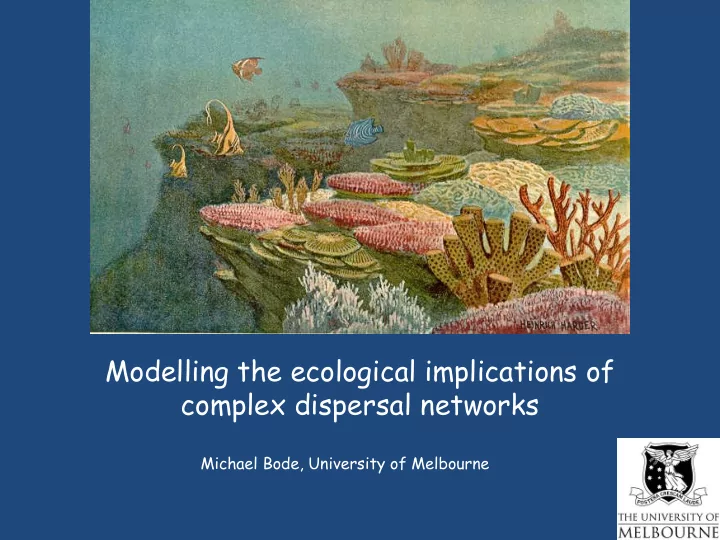

Modelling the ecological implications of complex dispersal networks Michael Bode, University of Melbourne
Population dynamics on a single patch In the absence of dispersal:
Population dynamics on a single patch Recruitment limitation: Doherty (1991) Ecology of Fishes on Coral Reefs
Metapopulations are populations of populations linked by dispersal Connectivity is interesting, complex and novel
Dispersal is essentially a linear driver of a multidimensional, nonlinear system • Dispersal is defined by connectivity matrix C • Matrix element c ij is the proportion of larvae from reef i that travel to reef j
Metacommunity models = Local processes (dynamically & temporally complex) + Connectivity (spatially & temporally complex)
Metacommunity models = Local processes (dynamically complex) + Connectivity (spatially complex) The role of mathematics is to provide some insight into what the result might look like Not necessarily prediction
How does dispersal interact with : • Population ecology • Evolution • Community dynamics How does this affect ecosystem dynamics and conservation management?
THREE COMMUNITY ECOLOGY EXAMPLES Small scale community dynamics 1. Asymmetric dispersal 2. Different dispersal abilities Large scale community dynamics 3. Dispersal differences on the GBR
Prologue: Competition in a single population
Prologue: Competition in a single population These two species cannot stably coexist “Gause’s exclusion principle”
Population dynamics on a connected patch d b c a
Competition across two patches Patch 1 Patch 2
Invasibility criteria 2 2
Invasibility criteria 2 2 The two patches are saturated, allowing us to express Linearise the system of equations around the two extinction points:
Invasibility criteria If the dominant eigenvector of the Jacobian at both extinction points is greater than 1, coexistence is possible
Example 1: Asymmetric dispersal patterns
Coexistence via asymmetric dispersal • What ecological mechanisms could drive different dispersal patterns for different species? • How does this manifest in larger metapopulations? • Is the coexistence robust to reasonable variation?
Example 2: dispersal differences and coexistence • Two species, identical at a local scale • Larval dispersal stages of slightly different lengths. d ij • Three identical patches
Dispersal differences and coexistence
Dispersal differences and coexistence
Coexistence is possible if each species is a superior disperser over one of the inter-patch distances However, this is neither necessary nor sufficient.
Dispersal differences support coexistence that: • Is simple and intuitive • Can create quite complex patterns • Does not depend on local competitive advantage • Creates stable geographic replacement • Driven by common factors
Example 3: GBR dispersal differences Williams (1991) Patterns and processes in the distribution of coral reef fishes. In:The Ecology of Fishes on Coral Reefs (Ed. P.F. Sale)
Theoretical proof involves drastic simplifications: • Simple, three-patch landscape • Deterministic, isotropic dispersal • No temporal variation
Interannual variation Interspecific variation
Coexistence is still possible when dispersal involves: • Realistic patch distributions • Multiple species • Biophysical drivers • Temporal stochasticity (%)
Recommend
More recommend